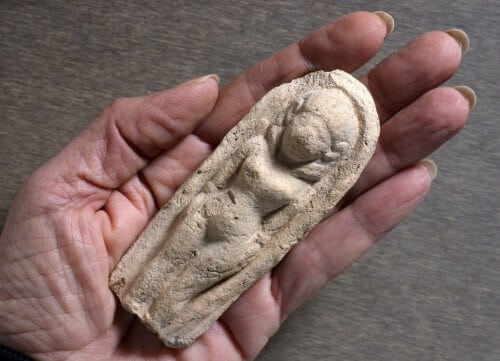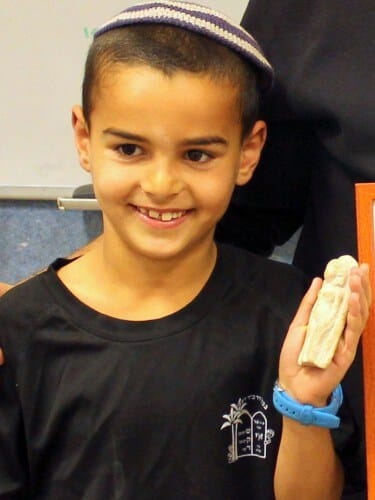The representatives of the Antiquities Authority awarded him a certificate of appreciation for his good citizenship

A 3400-year-old statuette was recently discovered by a 7-year-old boy during a trip. 7-year-old Uri Greenhut, from the settlement of Tel Ta'Aumim in the Beit Shean valley, went on a trip with friends at the beginning of the week, accompanied by the father of one of the children. When they were climbing the archaeological mound Tel Rehov, Uri came across a stone that moved to the side, and suddenly he saw a figure covered in earth. Uri rubbed off the mud that was stuck to the object, and thus discovered the clay figurine.
Moriah Greenhot, Uri's mother, says that "Uri came home with the impressive statuette, and the excitement was great. We explained to him that it was an ancient object and that the Antiquities Root preserves the findings for the general public."
The Greenhut family handed the find over to the Antiquities Authority, and representatives of the authority came to the Shaked Elementary School in Kibbutz Sde Eliyahu, in order to present Uri with a certificate of appreciation for his good citizenship and tell what is known about the statuette. Esther Ledel, the class teacher She said that "the class was amazing! The archaeologists entered the classroom during Torah class, and we just learned that Rachel stole the the therapies of Laban Abia (Genesis chapter XNUMX). I explained that the teraps were statues used in pagan worship, and suddenly, I realize that here, those teraps, are right inside the classroom!"
The clay figurine is a figure of a standing naked woman, made by pressing soft clay into a mold.

Amichai Mazar, professor emeritus from the Hebrew University and head of the Tel Rehov archeological excavation expedition, examined the figurine and noted that it is "typical of the Canaanite culture of the 15th to 13th centuries AD." Some scholars believe that the figure depicted here is a flesh and blood woman, while others see her as the fertility goddess Ashtoreth, known from Canaanite sources and the Bible. There is a high probability that the term "therapies" mentioned in the Bible does refer to figurines of this type." Mazar adds that "it seems that the figurine belonged to one of the residents of the city of Rehov, which was then subject to the central government of the pharaohs of Egypt."

One response
well done
And there is a dignified Poe